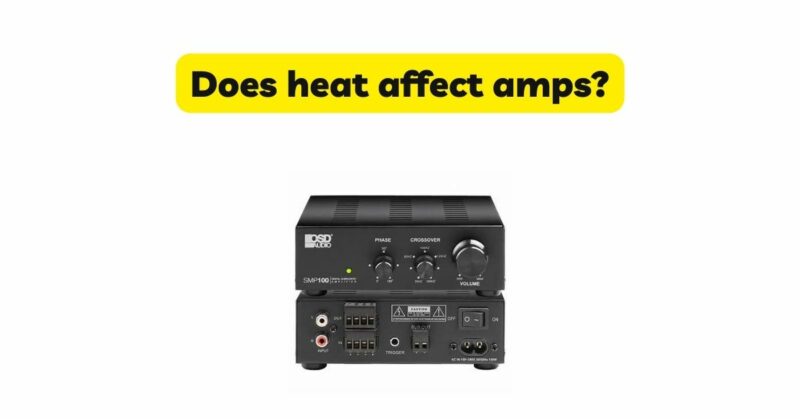Amplifiers play a crucial role in audio systems, providing the power necessary to drive speakers and deliver clear and dynamic sound. However, heat is a factor that can significantly impact the performance, reliability, and longevity of amplifiers. In this article, we will delve into the effects of heat on amplifiers, discussing how heat affects various components, potential consequences of excessive heat, and the measures you can take to mitigate heat-related issues. By understanding the relationship between heat and amplifiers, you can ensure optimal performance and protect your investment.
Heat and Amplifiers: A Closer Look
- Heat Generation in Amplifiers
Amplifiers inherently generate heat during their operation due to the conversion of electrical energy into sound energy. This process involves the amplification of electrical signals and the subsequent transformation into sound waves through speakers. Heat is a byproduct of this energy conversion and is generated within the amplifier’s circuitry and components.
- Factors Affecting Heat Generation
Several factors contribute to the heat generated by amplifiers:
a. Power Output: The power output of an amplifier influences heat generation. Amplifiers driven near or beyond their maximum power capacity tend to work harder, resulting in increased heat production.
b. Inefficient Design: The design and construction of amplifiers can impact their heat dissipation capabilities. Inefficient designs with inadequate cooling mechanisms, such as insufficient heat sinks or ventilation, can lead to inadequate heat dissipation and higher operating temperatures.
c. Ambient Temperature: The ambient temperature in which the amplifier operates also affects its heat generation. Higher ambient temperatures reduce the efficiency of heat dissipation, making it more challenging for the amplifier to cool down.
Effects of Excessive Heat on Amplifiers
- Component Degradation: Excessive heat can cause damage to the internal components of an amplifier over time. Elevated temperatures can lead to the degradation of delicate electronic components, such as transistors, capacitors, and resistors. Component degradation can result in reduced performance, increased distortion, or even complete amplifier failure.
- Reduced Lifespan: Prolonged exposure to high temperatures can significantly reduce the lifespan of an amplifier. Excessive heat places additional stress on the internal components, accelerating their wear and tear. Amplifiers subjected to continuous high temperatures are more likely to fail prematurely.
- Thermal Throttling and Protection Mechanisms: To protect themselves from damage, amplifiers incorporate thermal protection mechanisms. When the temperature exceeds safe limits, the amplifier may engage thermal throttling, reducing the output power to dissipate heat. In severe cases, the amplifier may shut down or enter protection mode to prevent further damage.
Mitigating Heat-Related Issues
- Adequate Ventilation: Ensure that the amplifier has proper ventilation to facilitate heat dissipation. Place the amplifier in a well-ventilated area, away from heat sources and obstructions that can impede airflow. Allow sufficient space around the amplifier for heat to escape.
- Cooling Mechanisms: Consider amplifiers that incorporate effective cooling mechanisms, such as large heat sinks, fans, or active cooling systems. These features help dissipate heat efficiently and maintain lower operating temperatures.
- Operating Conditions: Operate the amplifier within its recommended operating conditions. Avoid pushing the amplifier to its maximum power capacity for extended periods. If the amplifier feels excessively hot to the touch, consider reducing the volume level or providing additional cooling measures.
- Regular Maintenance: Perform regular maintenance on the amplifier to keep it in optimal condition. Clean the amplifier to remove dust and debris that can accumulate and hinder heat dissipation. Follow the manufacturer’s guidelines for maintenance, including periodic inspection and cleaning of internal components.
- Ambient Temperature Control: Maintain a suitable ambient temperature for the amplifier. Avoid placing the amplifier in hot environments or exposing it to direct sunlight, as these conditions can increase the overall temperature and strain the cooling capabilities.
- Power Management: Utilize efficient power management techniques, such as using standby modes or turning off the amplifier when not in use. This reduces unnecessary heat generation and extends the amplifier’s lifespan.
Conclusion
Heat has a significant impact on the performance, reliability, and longevity of amplifiers. Excessive heat can lead to component degradation, reduced lifespan, and the activation of thermal protection mechanisms. By understanding the factors that contribute to heat generation, such as power output and design, and implementing mitigation strategies like adequate ventilation, cooling mechanisms, and proper operating conditions, you can protect your amplifier from heat-related issues. Regular maintenance, ambient temperature control, and efficient power management techniques further contribute to the optimal performance and longevity of amplifiers. By prioritizing heat management, you can ensure the consistent delivery of high-quality sound and extend the lifespan of your amplifier for years to come.


